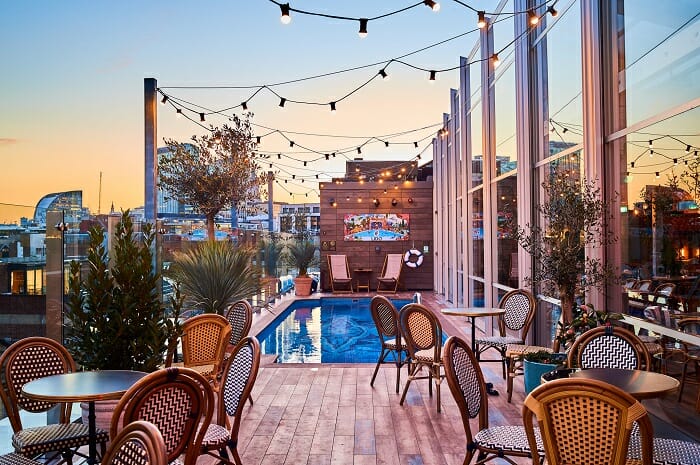
One year on from its opening, The Curtain, an industrial jewel in the heart of Shoreditch, London, extends its offering with an inspirational co-working space within the distinctive hotel and members club.
The Curtain has launched The Design Studio, an innovative new co-working space that mixes business with pleasure. Accessible to The Curtain’s members and hotel guests, the Design Studio functions both as a space to work and a cultural space, garlanded with beautiful artwork and a schedule of events and talks planned for the coming months.
Michael Achenbaum, The Curtain’s founder, comments on this increasing trend: “Communal workspaces are becoming an integral part of Londoners’ lives and the way in which modern people now conduct work. Our hotel is truly global, and this space ensures people can work hard by day in The Design Studio and then move through to our hotel’s other spaces to play harder!”
The Design Studio is the latest addition to The Curtain, hotelier Michael Achenbaum’s high-profile restaurant, hotel and members club in the heart of Shoreditch. Michael wanted the new building to reflect the area’s 19th century warehouse architectural heritage, industrial history, and current creativity. So he hired architects Dexter Moren Associates with their established track record of stunningly individual hotels, to transform this vision into reality. The Curtain, a nine storey, 120 key new build restaurant, hotel and members club was born.
From Medieval Priory to possible 17th century plague pit and rubbish dump for the Great Fire of London, Shoreditch has a chequered history, fading in and out of fashion over the centuries. In the late 19th century, it became the centre of the British furniture trade and the colour warehouses and cabinet factories that stood on The Curtain’s site until 1922 were the main inspiration for The Curtain’s façade materials and detailing.
Contemporary Shoreditch is in constant flux, developing from an unfashionable backwater to London’s capital of creativity in the 1990s, before evolving to become home to the UK’s technology start-up scene. As a result, the area has undergone significant gentrification accompanied and driven by a host of new art galleries, creative hubs, pop-up shops and restaurants, quirky pubs, clubs and eateries.
Dexter Moren Associate’s design reflects and reinterprets the industrial warehouse aesthetic of this part of Shoreditch, creating a modern hotel building which is highly sensitive to the site’s historical context whilst embracing its present sense of promise, life and theatre.
Explains Dexter Moren, Director of DMA: “The challenge was to sensitively reflect the past without becoming a pastiche. I think it’s worked – many people don’t realise The Curtain is a new build and we’ve had several compliments about our “conversion” project.”
In the cabinet factories and colour warehouses that previously stood on the site, the block was broken up vertically by the delivery doors to the warehouse; this also has the visual effect of breaking down a large facade into a smaller, more residential scale. The Curtain design uses this device to break up the visual mass of the building while retaining its overall cohesion by the use of brickwork throughout.
From an early stage, the façade design was such an important element that DMA decided to build 1-to-1 mock ups to test the design.
In addition to the urban red brickwork, profiled metal panels, large Crittall-style windows with deep reveals and bullnose brick sills complement the urban / industrial aesthetic and give the building a character and identity of its own. The 1.5 x 2m Crittal style window were used throughout the exterior, two per guestroom, glazing 50% of the facade to give a great sense of light in the building.
Continues Dexter: “Michael had a passionate vision for an exciting and vibrant destination, bringing together an eclectic mix of users and programmes with the very specific intention of creating unusual moments of interface. Our aim was to ensure this animation was as visible in the façade as it was in the interiors.”
Inside, The Curtain’s stylish eclecticism is rife thanks to interior design by global firm Duncan Miller Ullmann. Adorning the walls is feature art supplied by Mick Rock; famous for photographing music legends such as David Bowie, Lou Reed and Blondie, and for creating some of the key images of the Seventies. The artwork reflects the heady atmosphere of one of London’s hottest cultural centres.
A new world class cocktail bar, Green Room, adds a sumptuous elegance to The Curtain’s offering. Created by designer Ellie Horwell, jewel-toned tiles recall a souped-up representation of East London’s local pubs, juxtaposed against concrete surfaces and statement lighting as a nod to the hotel’s industrial surroundings. The space is outlined with lavish velvet banquettes and curtains, in peacock tones. Walls are adorned by striking graffiti murals by Xenz and a custom-made neon centrepiece hangs above the bar.
The Curtain possesses a total of five bars, including Billy’s Bar for members only, The Courtyard and the Red Rooster restaurant for both hotel guests and visitors. The first Red Rooster to open in Britain, American chef Marcus Samuelsson’s restaurant is equally famous for its food offering and its live music performances. The Curtain also features a second live music venue in a fully soundproofed basement, a state-of-the-art gym, wellness area with treatment and steam rooms, screening room, and ballroom. The jewel in its crown is a 1,600ft roof terrace offering stunning views across the City skyline with a Moroccan-style heated pool and LIDO: a bar/restaurant that has been adapted for the British weather with an innovative retractable roof.
